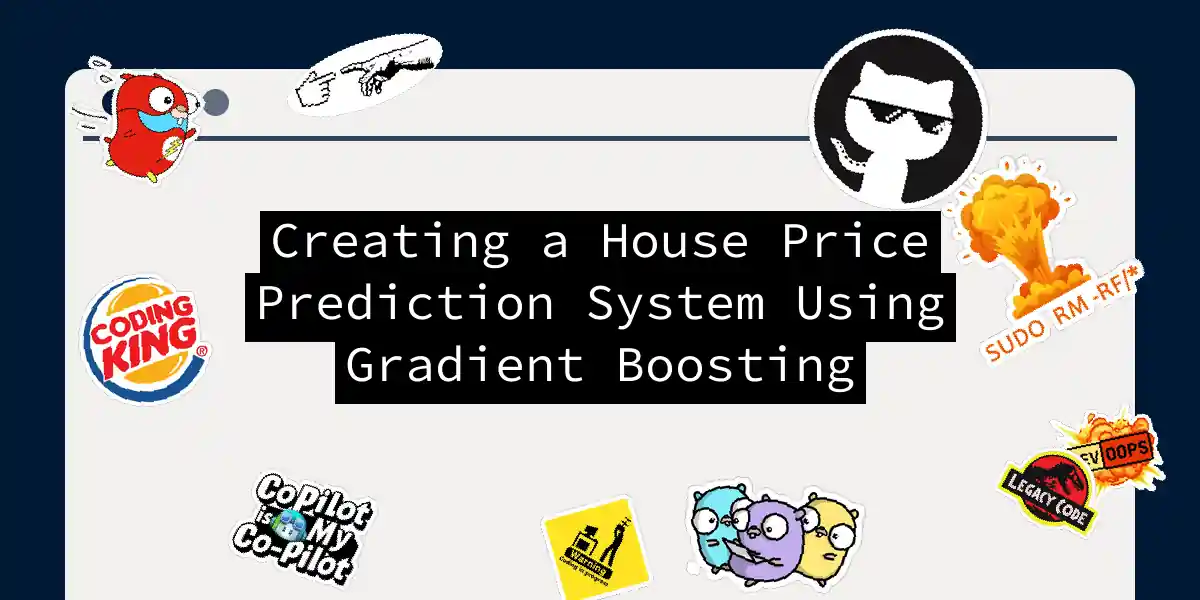Introduction to House Price Prediction
Predicting house prices is a complex task that involves a multitude of factors, from the physical condition of the property to its location and surrounding environment. With the rise of machine learning, developers and real estate enthusiasts have found powerful tools to make accurate predictions. In this article, we will delve into the world of gradient boosting and how it can be used to create a robust house price prediction system.
Why Gradient Boosting?
Gradient boosting is a popular machine learning algorithm known for its high accuracy and flexibility. It works by combining multiple weak models to create a strong predictive model. This technique is particularly effective in handling complex datasets and non-linear relationships, making it ideal for house price prediction.
Key Components of Gradient Boosting
- Decision Trees: The core of gradient boosting algorithms are decision trees. These trees are used to make predictions based on the input features.
- Boosting: The algorithm iteratively adds decision trees to the model, with each new tree attempting to correct the errors of the previous trees.
- Gradient Descent: The process of adding trees is guided by gradient descent, which minimizes the loss function.
Setting Up the Environment
Before diving into the code, ensure you have the necessary libraries installed. Here’s a quick setup using Python:
pip install pandas scikit-learn xgboost joblib
Data Preparation
Data preparation is crucial for any machine learning model. Here’s a step-by-step guide on how to prepare your dataset:
Loading the Data
import pandas as pd
# Load the dataset
df = pd.read_csv("ml_house_dataset.csv")
Exploring the Data
Understanding your data is key. Here’s a simple way to get an overview:
print(df.head())
print(df.info())
print(df.describe())
Handling Missing Values
Missing values can significantly impact your model’s performance. Here’s how you can handle them:
# Check for missing values
print(df.isnull().sum())
# Fill missing values with appropriate strategies (e.g., mean, median, imputation)
df['column_name'] = df['column_name'].fillna(df['column_name'].mean())
Feature Engineering
Feature engineering involves creating new features that can help improve the model’s accuracy. For house price prediction, features like the number of bedrooms, bathrooms, square footage, and year built are crucial.
# Example of feature engineering
df['age'] = df['year_built'] - df['year_sold']
df['rooms_per_sqft'] = df['total_rooms'] / df['total_sqft']
Training the Model
Now that your data is ready, it’s time to train the gradient boosting model.
Splitting the Data
from sklearn.model_selection import train_test_split
X = df.drop('sale_price', axis=1) # Features
y = df['sale_price'] # Target variable
X_train, X_test, y_train, y_test = train_test_split(X, y, test_size=0.2, random_state=42)
Training the Gradient Boosting Model
import xgboost as xgb
from sklearn.metrics import mean_squared_error
# Initialize the XGBoost model
model = xgb.XGBRegressor(objective='reg:squarederror', max_depth=6, n_estimators=1000, learning_rate=0.1)
# Train the model
model.fit(X_train, y_train)
# Make predictions
y_pred = model.predict(X_test)
# Evaluate the model
mse = mean_squared_error(y_test, y_pred)
print(f"Mean Squared Error: {mse}")
System Architecture
Here’s a high-level overview of the system architecture using a flowchart:
Model Evaluation and Optimization
Evaluating the model is crucial to ensure it performs well. Here are some steps to evaluate and optimize your model:
Metrics
Use metrics like Mean Squared Error (MSE), Mean Absolute Error (MAE), and R-Squared to evaluate the model’s performance.
from sklearn.metrics import mean_absolute_error, r2_score
mae = mean_absolute_error(y_test, y_pred)
r2 = r2_score(y_test, y_pred)
print(f"Mean Absolute Error: {mae}")
print(f"R-Squared: {r2}")
Hyperparameter Tuning
Hyperparameter tuning can significantly improve the model’s performance. You can use GridSearchCV or RandomizedSearchCV from scikit-learn.
from sklearn.model_selection import GridSearchCV
param_grid = {
'max_depth': [3, 5, 7],
'learning_rate': [0.1, 0.05, 0.01],
'n_estimators': [500, 1000, 2000]
}
grid_search = GridSearchCV(model, param_grid, cv=5, scoring='neg_mean_squared_error')
grid_search.fit(X_train, y_train)
print(f"Best Parameters: {grid_search.best_params_}")
print(f"Best Score: {grid_search.best_score_}")
Deployment
Once your model is trained and optimized, you can deploy it using a web framework like Flask.
Basic Flask App
Here’s a simple example of how to deploy your model using Flask:
from flask import Flask, request, jsonify
app = Flask(__name__)
@app.route('/predict', methods=['POST'])
def predict():
data = request.get_json()
input_df = pd.DataFrame(data)
prediction = model.predict(input_df)
return jsonify({'prediction': prediction.tolist()})
if __name__ == '__main__':
app.run(debug=True)
Conclusion
Creating a house price prediction system using gradient boosting is a powerful way to leverage machine learning for real-world applications. By following the steps outlined in this article, you can build a robust and accurate model that can help both developers and buyers make informed decisions. Remember, the key to success lies in careful data preparation, model evaluation, and continuous optimization.
Final Thoughts
House price prediction is not just about numbers; it’s about understanding the intricate relationships between various factors that influence the real estate market. With gradient boosting, you have a versatile tool that can handle these complexities with ease. So, the next time you’re thinking of buying or selling a house, consider the power of machine learning to guide your decision.
This article has provided a comprehensive guide on how to create a house price prediction system using gradient boosting. From data preparation to model deployment, each step is crucial in building an accurate and reliable system. Whether you’re a seasoned developer or just starting out in machine learning, this approach can help you navigate the complexities of real estate pricing with confidence. Happy coding
